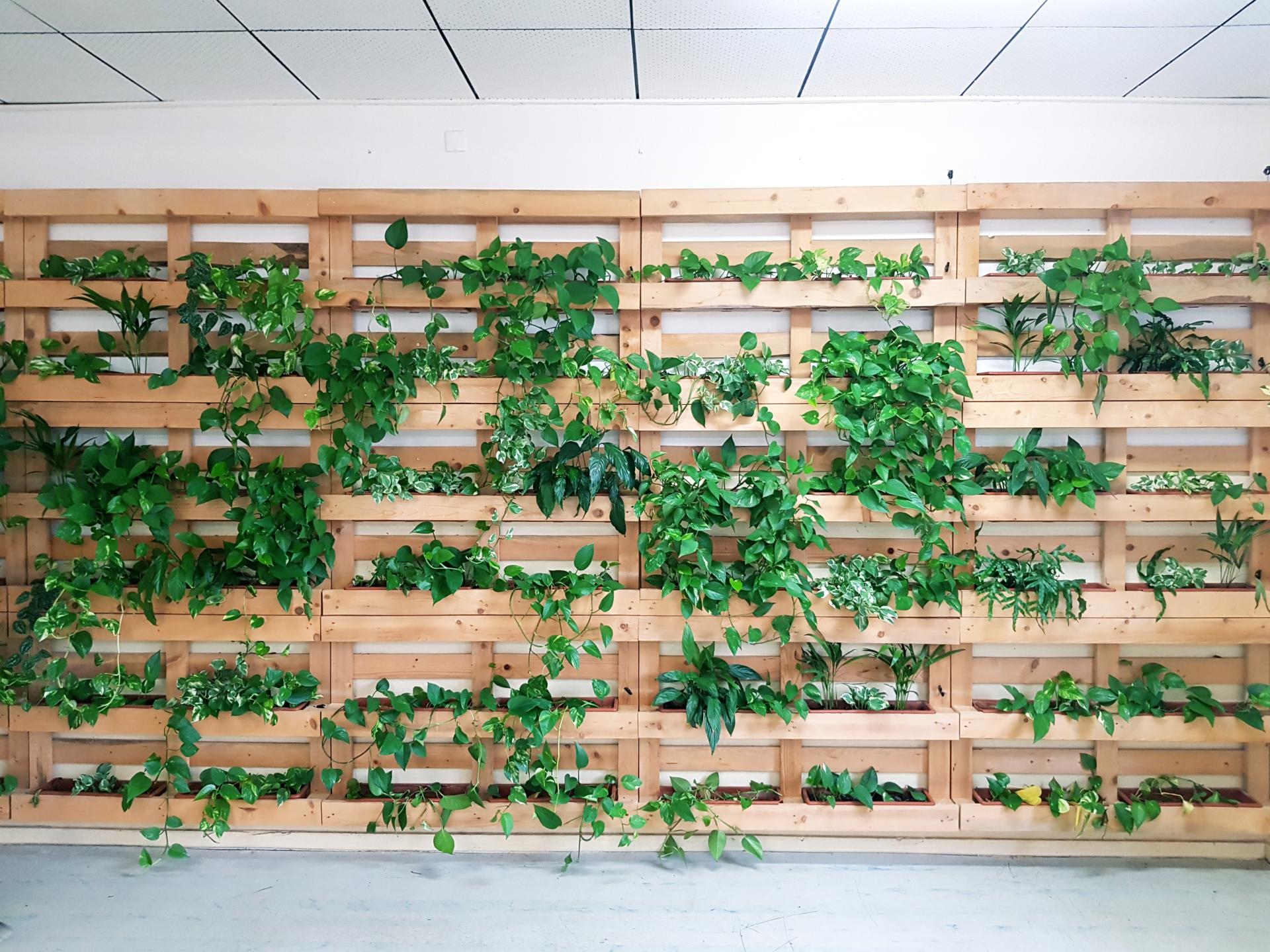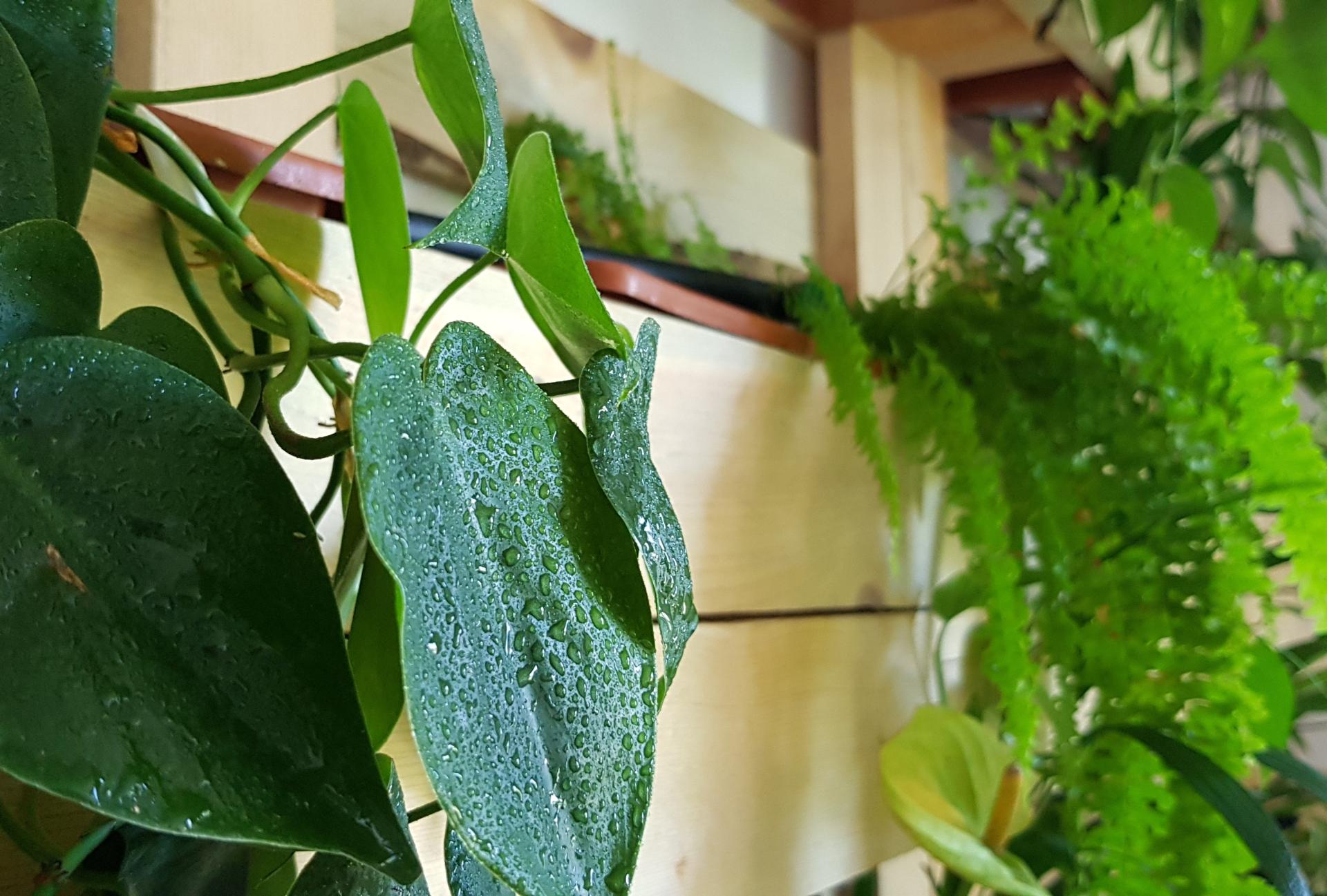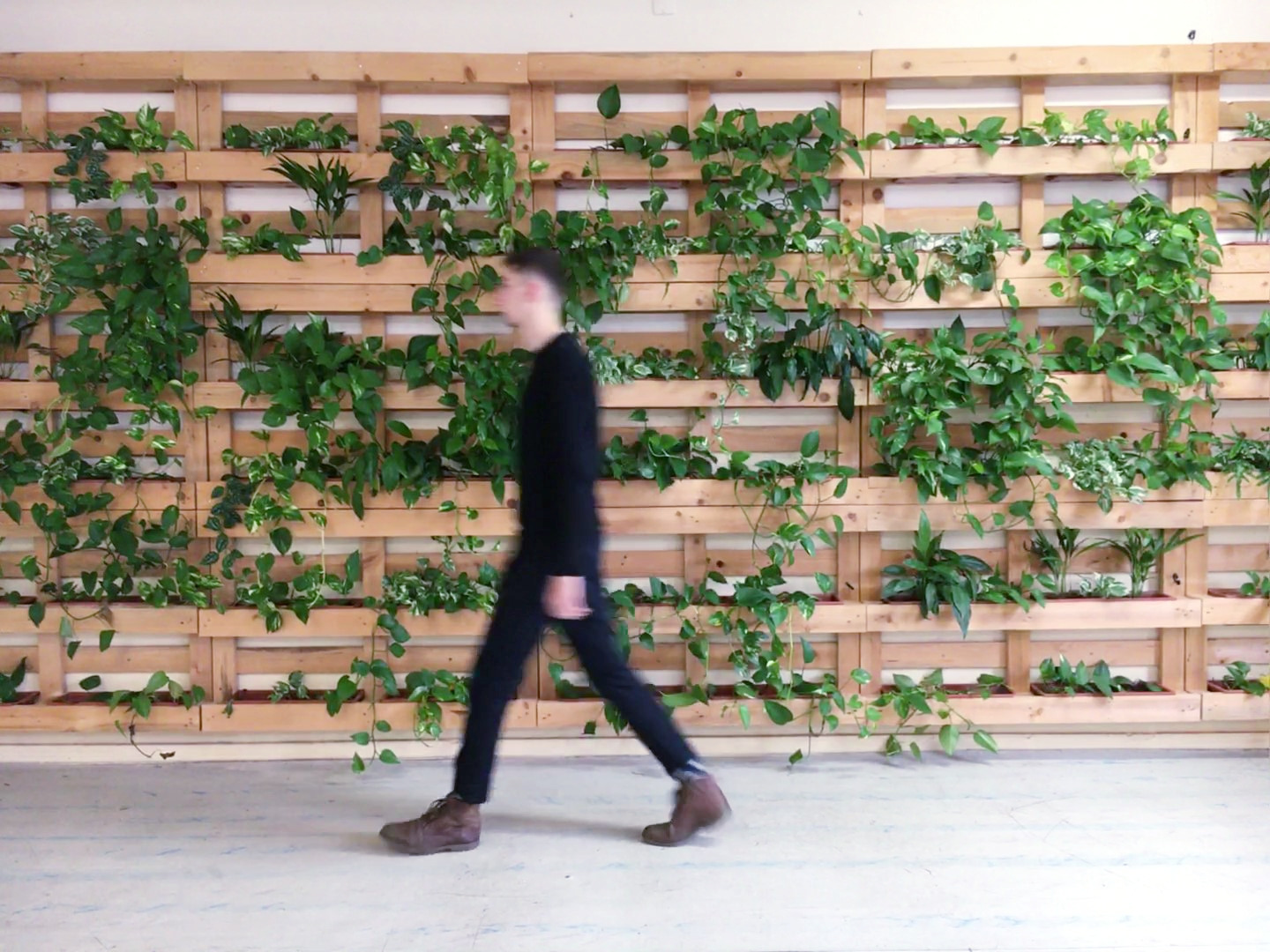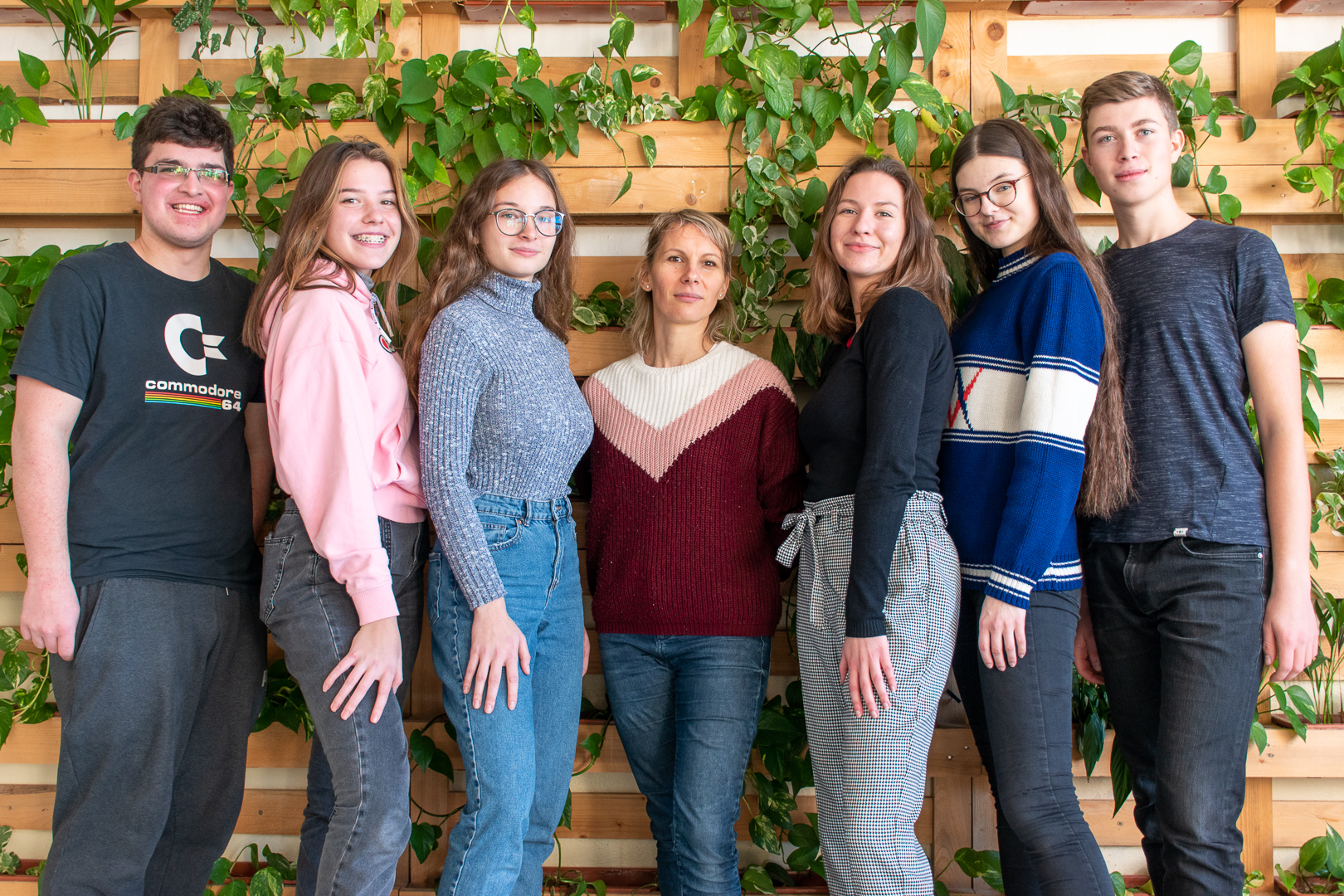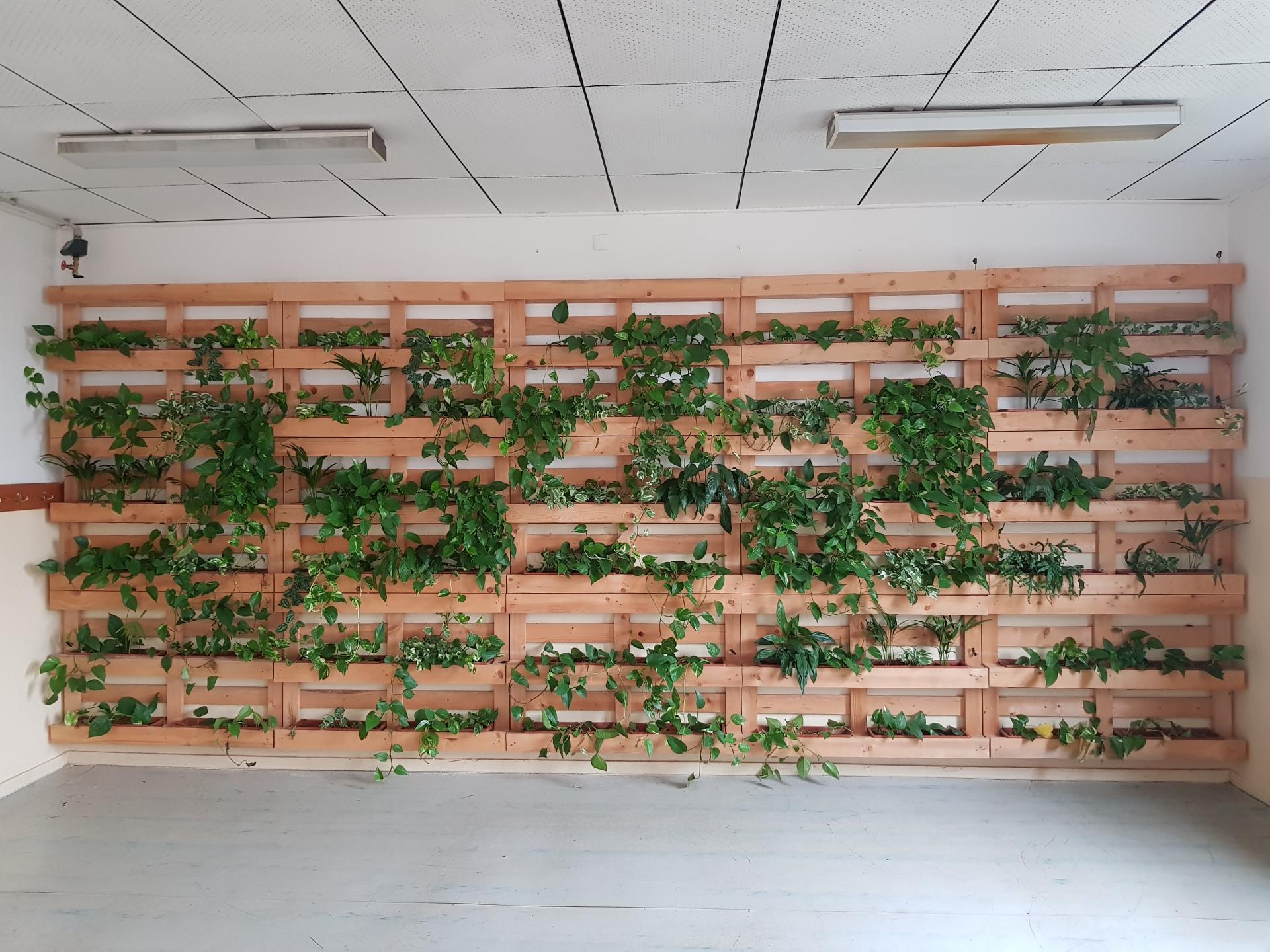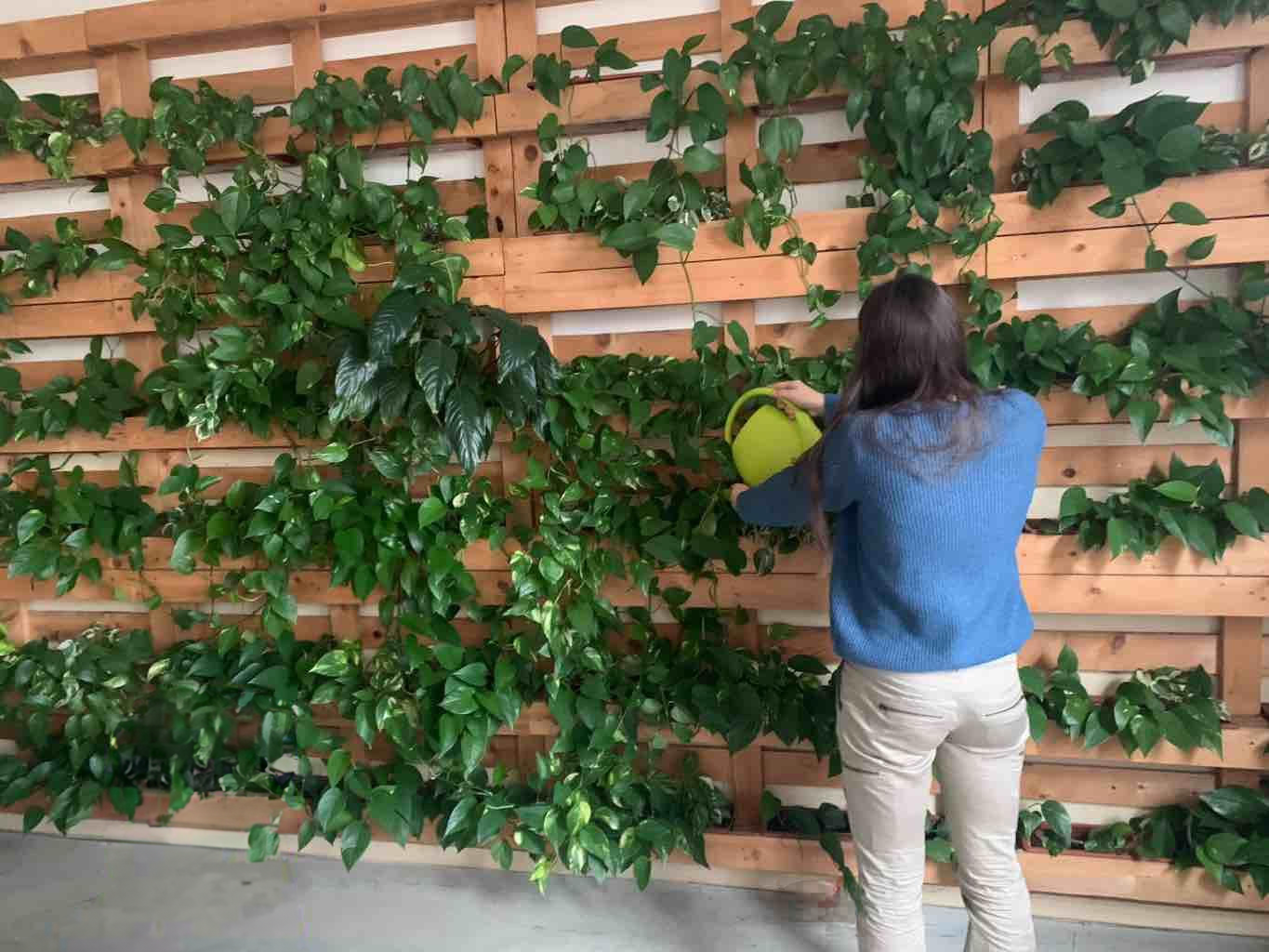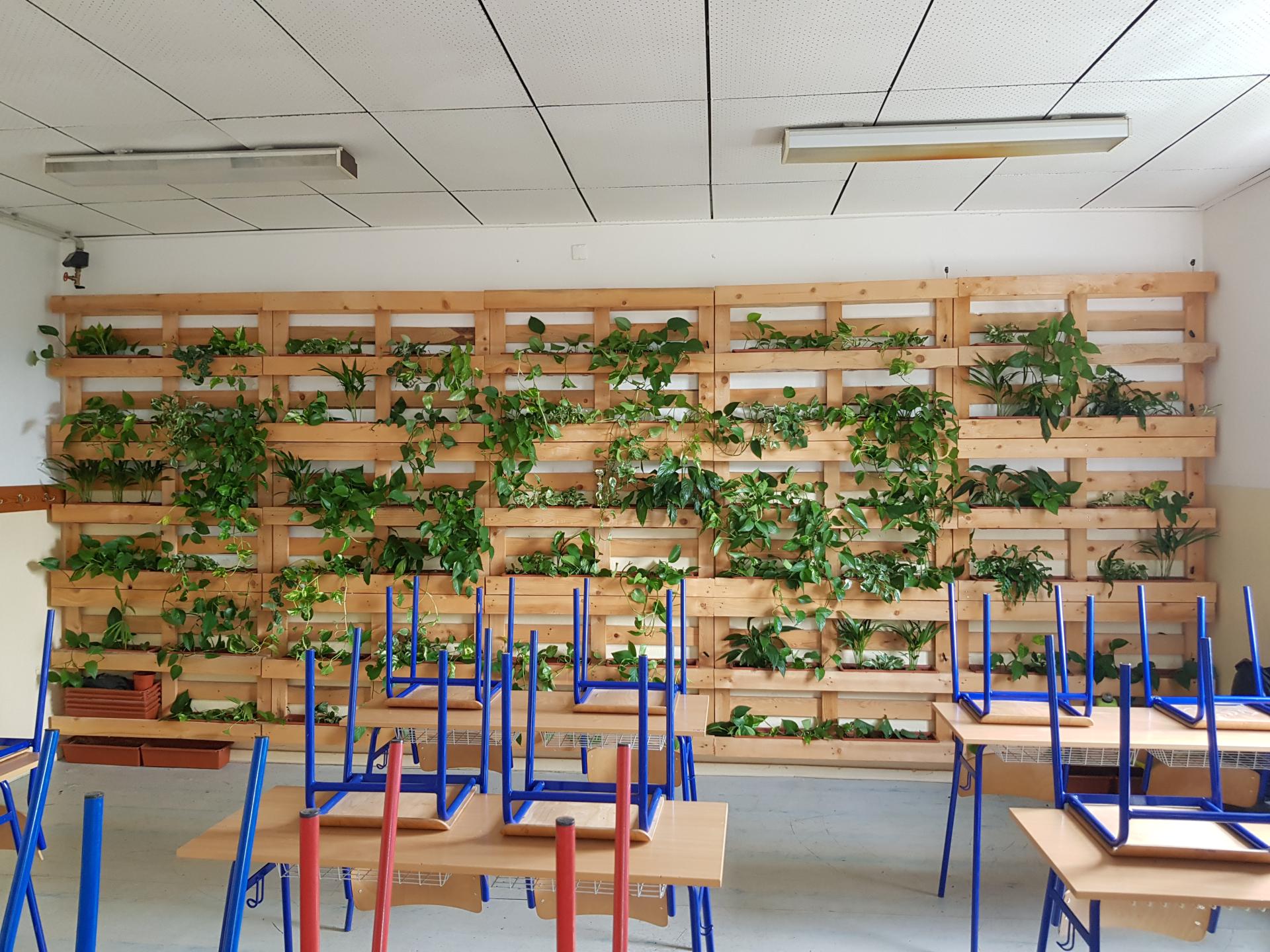Green Wall
Basic information
Project Title
Green Wall
Full project title
Student-led transformation of a classroom wall into vertical greenery element
Category
Reconnecting with nature
Project Description
Education environment is exceptionally important when it comes to personal development of students. Apart from providing knowledge, it can shape them into being more creative and care-taking human beings. That was the reason why the Green Wall project was created. It transforms a monotonous classroom into a space where the nature is dominant. It brings greenery to the interior and creates visual and emotional bond to nature. It teaches students to take care of the most valuable thing we have.
Geographical Scope
Local
Project Region
Liptovký Mikuláš, Slovakia
Urban or rural issues
Mainly urban
Physical or other transformations
It refers to a physical transformation of the built environment (hard investment)
EU Programme or fund
No
Description of the project
Summary
The way spaces where students learn and educators teach are crucial for their further development. They are interior places where these individuals spend most of their childhood and teenage years and in terms of teachers their professional career, yet they often lack natural elements and connection to nature. By bringing natural elements to the interior we can ensure that the connection to nature is maintained on a daily basis even when indoors.
The project of the Green Wall presents the idea of a student-led project, which transformed a monotonous classroom into a vertical greenery element. It shows how student engagement and bottom-up approach can have unique results when it comes to formation of student spaces and apart from the visual aspects can also bring attributes of sustainability and social interaction.
The Green Wall presents a transferable and affordable idea of how other educational spaces could be transformed and at the same time develop relationships and social sustainability among communities. It illustrates how engaging the community in the process of improvement of their space can have exceptional results in various aspects at the same time.
Apart from the visual transformation, the Green Wall improves overall air quality in the classroom, naturally moisturizes it and contributes to mental wellbeing of the students. It engages the students in the caretaking process and creates visual and emotional bonds to nature.
The project of the Green Wall presents the idea of a student-led project, which transformed a monotonous classroom into a vertical greenery element. It shows how student engagement and bottom-up approach can have unique results when it comes to formation of student spaces and apart from the visual aspects can also bring attributes of sustainability and social interaction.
The Green Wall presents a transferable and affordable idea of how other educational spaces could be transformed and at the same time develop relationships and social sustainability among communities. It illustrates how engaging the community in the process of improvement of their space can have exceptional results in various aspects at the same time.
Apart from the visual transformation, the Green Wall improves overall air quality in the classroom, naturally moisturizes it and contributes to mental wellbeing of the students. It engages the students in the caretaking process and creates visual and emotional bonds to nature.
Key objectives for sustainability
The Green Wall is composed of unnecessary wooden pallets from local warehouses. It recycles unwanted material that was not suitable for transport of goods anymore and gives it a new purpose and meaning. The pallets were grinded by hand tools and no other supplements in the form of wood polishers or oils were used in order to preserve the naturality of color and material. Wide range of greenery planted in the pots enhances the quality of the air and naturally moisturizes the environment where 26 students spend most of their daytime during their studies.
The project is not only environmentally sustainable - the minimum resources required for this project show that even projects that are economically sustainable and invest small capital could have unique results.
Additionally, engaging the whole community of students in the process opens the question of social sustainability and sustainability of relationships and inclusion which is equally important to environmental consciousness.
The project is not only environmentally sustainable - the minimum resources required for this project show that even projects that are economically sustainable and invest small capital could have unique results.
Additionally, engaging the whole community of students in the process opens the question of social sustainability and sustainability of relationships and inclusion which is equally important to environmental consciousness.
Key objectives for aesthetics and quality
The green wall is an exemplary example of a self design & build project. One of the main objectives of the project was to enhance the visuality of the monotonous high-school classroom by designing and constructing an element with aesthetic and social values.
The project implements the principles of biophilic design, which is known to integrate plants and natural elements to design solutions. The choice of plants and natural wood creates a calming and harmonious atmosphere reminiscent of natural environments. The every-day visual experience is substantial since the green wall is a dominant element in the classroom. It utilizes vertical space, adds depth and dimension to a wall that was previously unused. The verticality draws the eye upward making the space of the classroom more expansive. It is an element that cannot be overseen and therefore provides a constant connection to nature in the interior for the educators and students who spend most of their daytime in the classroom. It is a unique example of bringing natural elements to educational spaces which are often monotonous and with a small number of plants and greenery.
The project implements the principles of biophilic design, which is known to integrate plants and natural elements to design solutions. The choice of plants and natural wood creates a calming and harmonious atmosphere reminiscent of natural environments. The every-day visual experience is substantial since the green wall is a dominant element in the classroom. It utilizes vertical space, adds depth and dimension to a wall that was previously unused. The verticality draws the eye upward making the space of the classroom more expansive. It is an element that cannot be overseen and therefore provides a constant connection to nature in the interior for the educators and students who spend most of their daytime in the classroom. It is a unique example of bringing natural elements to educational spaces which are often monotonous and with a small number of plants and greenery.
Key objectives for inclusion
The Green Wall used a collaborative design process and engaged the whole community of students into its creation and implementation. Inputs from students with various backgrounds and experience was encouraged in order to stimulate the discussion and decision making.
The Green Wall uses universal design principles and the modularity of wooden pallets allow for it to be implemented and adapted to various spaces and communities. It used inexpensive recycled materials (wooden pallets) that are found in every urban and even rural areas and thus are easily accessible. Using these recycled materials ensures that the project is financially sustainable and accessible even for communities with less capital.Moreover, even small financial investments in plants can show positive results since the plants can be divided as they grow. Thus, it provides a low-cost alternative to expensive prefabricated green wall systems.
The construction method does not require any complicated technical experience or supervision since the whole process of design and construction was done by at that time 18-year-old students.
The Green Wall uses universal design principles and the modularity of wooden pallets allow for it to be implemented and adapted to various spaces and communities. It used inexpensive recycled materials (wooden pallets) that are found in every urban and even rural areas and thus are easily accessible. Using these recycled materials ensures that the project is financially sustainable and accessible even for communities with less capital.Moreover, even small financial investments in plants can show positive results since the plants can be divided as they grow. Thus, it provides a low-cost alternative to expensive prefabricated green wall systems.
The construction method does not require any complicated technical experience or supervision since the whole process of design and construction was done by at that time 18-year-old students.
Results in relation to category
Implementation of the Green Wall opens discussion about creating a healthy and creative environment in schools. The way we perceive and form educational spaces is crucial for the future of the students. Reconnecting with nature is not only a matter of exterior. As we spend more and more time in the interior spaces - students and teachers included - it is extremely important how they reflect connection to nature as well. By fostering the idea of implementation of greenery elements in the interior space, we can ensure that the nature is present in our lives which also creates emotional and personal bond to the environment
The personal and emotional bond is also what the Green Wall brought to the community of the classroom. We, the students, got hands-on experience to create, manage, organize and take care of a piece of nature and have it present in our daily lives even when indoors.
The project also illustrates how the decisions about the places where students learn should be created and shows that creating a space for independent bottom-up student initiatives brings exceptional results.
Furthermore, the Green Wall and its numerous plants improved the air quality, which is highly important for a space where 26 people gather for a whole day and spend most of their time.
Last but not least, the Green Wall enhanced the visuality of the classroom and had positive impacts on the perception of the space by students and teachers.
The Green Wall is a phenomenon that connected the students with each other and with nature, enhanced the visuality of the classroom, improved the quality of the environment - it is an example of how other educational institutions could take similar steps to improve their spaces and enhance the relationship with nature and their community.
The personal and emotional bond is also what the Green Wall brought to the community of the classroom. We, the students, got hands-on experience to create, manage, organize and take care of a piece of nature and have it present in our daily lives even when indoors.
The project also illustrates how the decisions about the places where students learn should be created and shows that creating a space for independent bottom-up student initiatives brings exceptional results.
Furthermore, the Green Wall and its numerous plants improved the air quality, which is highly important for a space where 26 people gather for a whole day and spend most of their time.
Last but not least, the Green Wall enhanced the visuality of the classroom and had positive impacts on the perception of the space by students and teachers.
The Green Wall is a phenomenon that connected the students with each other and with nature, enhanced the visuality of the classroom, improved the quality of the environment - it is an example of how other educational institutions could take similar steps to improve their spaces and enhance the relationship with nature and their community.
How Citizens benefit
STUDENTS ENGAGED IN THE PROJECT:
Design and coordination - Dominik Nosko
Logistics - Ivana Hanáková
Finances - Karolína Littvová
Planting and care-taking - Terézia Dančová, Petra Daubnerová, Šimon Dvorský, Krištof Fabian, Sylvia Gulášová, Barbora Halušková, Ľudmila Hurajtová, Viktória Husarčíková, Natália Jarottová, Nikola Jurčová, Sofia Kováčová, Nina Kubová, Veronika Littvová, Timea Majzelová, Ján Matejko, Vladimíra Meľuchová, Klára Nemčeková, Dominika Praženicová, Nikola Rajniaková, Veronika Števíková, Emília Uličná, Ema Urbánková, Lukáš Vozár
It was made sure that everyone in the classroom is fully engaged in the process of creation and implementation and could have a say about the project - students voted and discussed what the trajectory and approach should be. Engaging the whole community in the decision making not only imporved relationships of the students, but resulted in exceptional ideas driven by the discussions.
After completion, the classroom was used not only by the students who completed the project, but by many other students at the high school, therefore it affected the learning environment of many others. As of today, the third generation of students is responsible for taking care of the Green Wall and it is still a flourishing element in the classroom even after departure of the authors in 2021.
Design and coordination - Dominik Nosko
Logistics - Ivana Hanáková
Finances - Karolína Littvová
Planting and care-taking - Terézia Dančová, Petra Daubnerová, Šimon Dvorský, Krištof Fabian, Sylvia Gulášová, Barbora Halušková, Ľudmila Hurajtová, Viktória Husarčíková, Natália Jarottová, Nikola Jurčová, Sofia Kováčová, Nina Kubová, Veronika Littvová, Timea Majzelová, Ján Matejko, Vladimíra Meľuchová, Klára Nemčeková, Dominika Praženicová, Nikola Rajniaková, Veronika Števíková, Emília Uličná, Ema Urbánková, Lukáš Vozár
It was made sure that everyone in the classroom is fully engaged in the process of creation and implementation and could have a say about the project - students voted and discussed what the trajectory and approach should be. Engaging the whole community in the decision making not only imporved relationships of the students, but resulted in exceptional ideas driven by the discussions.
After completion, the classroom was used not only by the students who completed the project, but by many other students at the high school, therefore it affected the learning environment of many others. As of today, the third generation of students is responsible for taking care of the Green Wall and it is still a flourishing element in the classroom even after departure of the authors in 2021.
Physical or other transformations
It refers to a physical transformation of the built environment (hard investment)
Innovative character
When it comes to the physical transformation of a school environment, most of the time ordinary and stereotypical solutions chosen by the school representatives enhance only the visual aspect of the space and are usually provided by a contractor or external firm. The project of the Green Wall completely reversed this process and implemented a bottom-up approach where we - the students - had a say in how our learning environment looks like.
During the creation of the concept, we put a strong emphasis not only on visual aspects, but also environmental and community attributes of the project where the whole classroom could be engaged in the process of creation - where the final result would serve as a community catalyst. We wanted to create an emotional bond to the Green Wall and our classroom environment by designing, organizing and constructing the whole project ourselves which helped us improve communicational, technical and logistical skills as well.
At the same time, having limited resources for the project, we aimed for accessible and non-expensive solutions that would not harm the environment by recycling used and unwanted wooden pallets. The result is a socially and environmentally sustainable project that engaged the whole classroom and changed the approach on how the decisions about spaces where students learn should be made.
During the creation of the concept, we put a strong emphasis not only on visual aspects, but also environmental and community attributes of the project where the whole classroom could be engaged in the process of creation - where the final result would serve as a community catalyst. We wanted to create an emotional bond to the Green Wall and our classroom environment by designing, organizing and constructing the whole project ourselves which helped us improve communicational, technical and logistical skills as well.
At the same time, having limited resources for the project, we aimed for accessible and non-expensive solutions that would not harm the environment by recycling used and unwanted wooden pallets. The result is a socially and environmentally sustainable project that engaged the whole classroom and changed the approach on how the decisions about spaces where students learn should be made.
Disciplines/knowledge reflected
The whole project of the Green Wall is student-led, therefore the whole design, communication process, consultation with different experts and finding the funding for it was done only by the students. This provided us with an exceptional hands-on experience and training of our communicational, logistical and organizational skills.
Since the greenery is the central attribute of the Green Wall, making sure that the right types of plants and soil chosen for this environment were crucial for the project, therefore we consulted our selection with a plant expert Mr. Peter Švitko. Plants that do not cause any problems to students with respiratory issues or allergies were chosen in order to create an environment suitable for everyone as proposed by Mr. Švitko. We highly valued his input since the classroom is now a welcoming environment despite the probable health complications of students. The members of the student group also communicated with the local warehouses which provided unwanted wooden pallets for a symbolic price and logistically organized their transport to the school classroom.
The fact that our high-school where the Green Wall was implemented did not have financial resources to provide for the project, forced us to find different ways of funding. Communication with the main sponsor Mondi Group PLC trained us how to communicate professionally with a corporation when demanding donations for the project. The total amount of 500€ provided by Mondi Group PLC was sufficient to cover all the expenses that the project required.
Since the greenery is the central attribute of the Green Wall, making sure that the right types of plants and soil chosen for this environment were crucial for the project, therefore we consulted our selection with a plant expert Mr. Peter Švitko. Plants that do not cause any problems to students with respiratory issues or allergies were chosen in order to create an environment suitable for everyone as proposed by Mr. Švitko. We highly valued his input since the classroom is now a welcoming environment despite the probable health complications of students. The members of the student group also communicated with the local warehouses which provided unwanted wooden pallets for a symbolic price and logistically organized their transport to the school classroom.
The fact that our high-school where the Green Wall was implemented did not have financial resources to provide for the project, forced us to find different ways of funding. Communication with the main sponsor Mondi Group PLC trained us how to communicate professionally with a corporation when demanding donations for the project. The total amount of 500€ provided by Mondi Group PLC was sufficient to cover all the expenses that the project required.
Methodology used
PART 1 - DESIGN
INITIATIVE
The initial idea was proposed by three students (Dominik, Ivana, Karolína) who presented the idea to the classroom which then voted on further approach. These three students were selected to be main communicators with the school representatives.
COMMUNICATION
The students initiated the approach by communicating the idea to principal Mrs. Jana Chaloupková who was open to the idea, however informed that the school does not have budget for the project and that it will have to be funded from other resources.
DESIGN
The details of the project were designed by the student Dominik Nosko who prepared the visualization of the Green Wall. These materials were further used for the presentation of the project.
FINANCES
Ivana Hanáková, responsible for finances, approached company Mondi Group PLC with the proposal for our project with the prospect of sponsorship and presented the idea using prepared materials.
LOGISTICS
After receiving the finances, the budget was created with a list of required material. Local warehouses were addressed with a request for unused wooden pallets. The students communicated with plant expert to make sure the choice of plants is suitable for the classroom environment, who then provided the plants from local businesses.
PART 2 - BUILD
CONSTRUCTION
All of the material (wooden pallets, pots, plants, soil, screws) was transported to the classroom. The students met there for a two-day workshop to construct the wall and plant the greenery. The wall is made of 15 wooden pallets, each fastened by 4 screws. Every pallet can hold 6 pots in the designated spaces. Usually, two pieces of greenery were planted in each pot.
QUESTIONAIRE
After the completion, a questionaire was sent out to the students of the high school in order to get feedback on the project and to find out about their opinion on greenery in educational space (results can be found in the attached PDF file).
INITIATIVE
The initial idea was proposed by three students (Dominik, Ivana, Karolína) who presented the idea to the classroom which then voted on further approach. These three students were selected to be main communicators with the school representatives.
COMMUNICATION
The students initiated the approach by communicating the idea to principal Mrs. Jana Chaloupková who was open to the idea, however informed that the school does not have budget for the project and that it will have to be funded from other resources.
DESIGN
The details of the project were designed by the student Dominik Nosko who prepared the visualization of the Green Wall. These materials were further used for the presentation of the project.
FINANCES
Ivana Hanáková, responsible for finances, approached company Mondi Group PLC with the proposal for our project with the prospect of sponsorship and presented the idea using prepared materials.
LOGISTICS
After receiving the finances, the budget was created with a list of required material. Local warehouses were addressed with a request for unused wooden pallets. The students communicated with plant expert to make sure the choice of plants is suitable for the classroom environment, who then provided the plants from local businesses.
PART 2 - BUILD
CONSTRUCTION
All of the material (wooden pallets, pots, plants, soil, screws) was transported to the classroom. The students met there for a two-day workshop to construct the wall and plant the greenery. The wall is made of 15 wooden pallets, each fastened by 4 screws. Every pallet can hold 6 pots in the designated spaces. Usually, two pieces of greenery were planted in each pot.
QUESTIONAIRE
After the completion, a questionaire was sent out to the students of the high school in order to get feedback on the project and to find out about their opinion on greenery in educational space (results can be found in the attached PDF file).
How stakeholders are engaged
STUDENTS ENGAGED IN THE PROJECT (LOCAL LEVEL):
27 students - iniciators and creators of the project
PLANTING AND GREENERY CONSULTATION (LOCAL LEVEL):
Ing. Peter Švitko - plants expert / care-taking consultation and irrigation
Mr. Švitko provided us with insignful information on the choice of plants and type of soil fot this specific environment
WOODEN PALLETS SUPPLIER (LOCAL LEVEL):
Eurom, s.r.o. - warehouse that provided us with unwanted wooden pallets (unwanted material was recycled)
PROJECT FUNDING/SPONSOR (REGIONAL LEVEL):
Mondi Group PLC - paper company that provided total amount of 500€ and was a partner thanks to which this project could be implemented
27 students - iniciators and creators of the project
PLANTING AND GREENERY CONSULTATION (LOCAL LEVEL):
Ing. Peter Švitko - plants expert / care-taking consultation and irrigation
Mr. Švitko provided us with insignful information on the choice of plants and type of soil fot this specific environment
WOODEN PALLETS SUPPLIER (LOCAL LEVEL):
Eurom, s.r.o. - warehouse that provided us with unwanted wooden pallets (unwanted material was recycled)
PROJECT FUNDING/SPONSOR (REGIONAL LEVEL):
Mondi Group PLC - paper company that provided total amount of 500€ and was a partner thanks to which this project could be implemented
Global challenges
MENTAL HEALTH ISSUES AND WELLBEING:
Educational environments can be stressful for both students and teachers. At the same time, they are spaces where students and teachers spend most of their time. With the increase of mental health issues nowadays, plants and greenery can serve as a mental well-being stimulus as they are believed to decrease stress and anxiety. By placing the Green Wall in educational spaces, we can ensure a healthy environment for both students and educators. Additionally, the presence of indoor plants or exposure to natural settings with greenery can boost mood and increase feelings of well-being. This is often referred to as the "biophilia hypothesis," which suggests that humans have an innate connection to nature.
MINDFULNESS, FOCUS AND COGNITIVE PERFORMANCE:
In today’s technological world, it is difficult to find natural elements in indoor environments, especially in schools where the students are expected to work with the latest technological enhancements. At the same time, it is important to find balance between artificial and natural. Taking care of plants requires attention and mindfulness, which can help students stay focused on the present moment and divert their thoughts from stressors. The act of nurturing and tending to plants can be calming and provide a sense of control and responsibility.
Educational environments can be stressful for both students and teachers. At the same time, they are spaces where students and teachers spend most of their time. With the increase of mental health issues nowadays, plants and greenery can serve as a mental well-being stimulus as they are believed to decrease stress and anxiety. By placing the Green Wall in educational spaces, we can ensure a healthy environment for both students and educators. Additionally, the presence of indoor plants or exposure to natural settings with greenery can boost mood and increase feelings of well-being. This is often referred to as the "biophilia hypothesis," which suggests that humans have an innate connection to nature.
MINDFULNESS, FOCUS AND COGNITIVE PERFORMANCE:
In today’s technological world, it is difficult to find natural elements in indoor environments, especially in schools where the students are expected to work with the latest technological enhancements. At the same time, it is important to find balance between artificial and natural. Taking care of plants requires attention and mindfulness, which can help students stay focused on the present moment and divert their thoughts from stressors. The act of nurturing and tending to plants can be calming and provide a sense of control and responsibility.
Learning transferred to other parties
Since the Green Wall is based on modularity of wooden pallets and their accessibility as a material, it can be easily replicated in other environments. Wooden pallets allow a wide range of variations in size or shape and thus can be adapted to different contexts. Individuals and communities can adapt the design to fit their specific needs and aesthetic preferences, which may differ from the more standardized designs of mainstream green wall systems.
Even with small investment to initial climbing plants, the Green Wall can flourish as the plants can be divided as they grow. Based on the choice of the greenery, the project can be placed both indoors and outdoors. The construction is not complicated as well since the whole installation process was completed at that time by 18-year old students with medium technical skills or experience.
Even with small investment to initial climbing plants, the Green Wall can flourish as the plants can be divided as they grow. Based on the choice of the greenery, the project can be placed both indoors and outdoors. The construction is not complicated as well since the whole installation process was completed at that time by 18-year old students with medium technical skills or experience.
Keywords
greenery
environmental education
participation
eco-conscious
student-led

